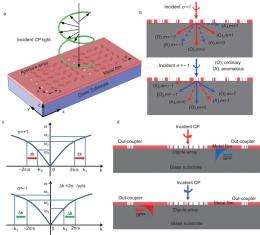April 8, 2013 weblog
Research group devises a way to control surface plasmon polaritons

(Phys.org) —A team made up of researchers from the U.K., China and Germany has developed, for the first time, a way to control surface plasmon polaritons (SPPs), perhaps paving the way to integrated plasmonic circuits. In their paper published in Light: Science & Applications, describing their achievement, the team details how they created a metal film with nanometer-sized holes in it set in a certain way to allow for controlling the quasiparticles that arise during the interaction between light and a metal surface.
The idea is essentially, to couple light to the surface of a metamaterial, in a specific direction. Normally, when light strikes such a surface, SPPs in the form of quasiparticles arise due to the mixing of light with surface electrons—they're part light and part electron wave and exist only very near the metal surface. When the SPPs are excited under normal conditions, they tend to propagate in every direction, which isn't very useful. In this new effort, the team devised a means for controlling the direction in which they flow.
To get the SPPs to move only in the desired direction, the team created what they describe as a "metasurface" by covering a material with a metal film that had rectangular nanometer-sized holes in it—all situated in a particular fashion to impact the quasiparticles in desired ways. In so doing, they found they could control the direction in which the SPPs flowed by switching the circular polarization direction of the light that was shined on it—right or left. The holes cause phase delays, the researchers explain, which breaks the symmetry of the excitation of the SPPs in two directions, thus their orientation is critical. Because of that they found that that they could cause the SPPs to run in one or the other direction on command, by simply adjusting the apertures.
The team took their research further by adding polarization modulators to the film which resulted in the creation of a plasmonic circuit that they were able to control. They next plan to improve the coupling that occurs in the film and to perhaps find a means for allowing LCD control of the propagation of the SPPs—that, they say, would allow for the design of much more complex circuits.
More information: Helicity dependent directional surface plasmon polariton excitation using a metasurface with interfacial phase discontinuity, Light: Science & Applications (2013) 2, e70; doi:10.1038/lsa.2013.26 . Published online 29 March 2013
Abstract
Surface plasmon polaritons (SPPs) have been widely exploited in various scientific communities, ranging from physics, chemistry to biology, due to the strong confinement of light to the metal surface. For many applications, it is important that the free space photon can be coupled to SPPs in a controllable manner. In this Letter, we apply the concept of interfacial phase discontinuity for circularly polarizations on a metasurface to the design of a novel type of polarization-dependent SPP unidirectional excitation at normal incidence. Selective unidirectional excitation of SPPs along opposite directions is experimentally demonstrated at optical frequencies by simply switching the helicity of the incident light. This approach, in conjunction with dynamic polarization modulation techniques, opens gateway towards integrated plasmonic circuits with electrically reconfigurable functionalities.
via Nanotechweb
© 2013 Phys.org



















